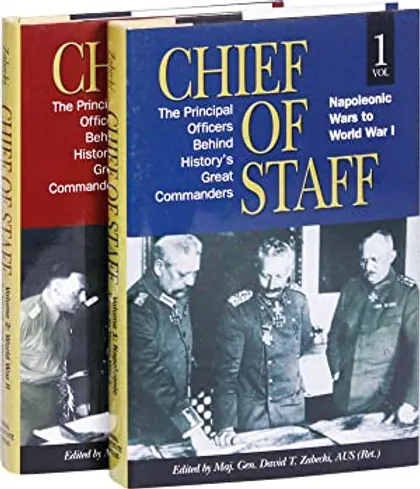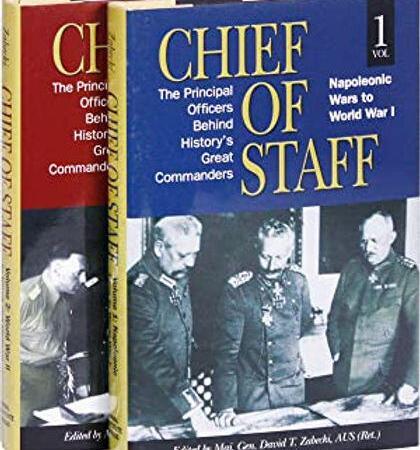The Principal Officers Behind History’s Great Commanders
David Zabecki (Ed.), (Naval Institute Press, 2 Vols., 2008). pp. 484.

Source: amazon.com
In attempting to shed light on some of the lesser dramatis personae of modern military history, Zabecki has assembled a collection of 28 essays covering 30 of modern military history’s lesser-known greats.
As an exploratory work on the role of the Chief of Staff, Zabecki et al., don’t quite hit the mark as the work suffers from a lack of balance and context.
First off, two volumes seem unnecessary at a total of 484 pages including chronology and bibliography. Additionally, whilst the 28 (well-written) essays serve up concise short introductions to our protagonists, they leave little room for analysis or rumination.
Furthermore, the decision to add a chronology to each essay takes upwards of 60 pages of text; this may seem trite, but at an average length of 13 pages—including notes—there is scope for enlargement.
In Vol.1, eight of fourteen essays are devoted to Germans, one during the Napoleonic Wars, one during the wars of German unification, with reference to the Franco-Prussian War and the Austro-Prussian wars.
The remaining six Germans saw service in World War One; whilst it may seem sensible to have a high number of Germans from this war, there is only one essay for each US, UK, and French subjects—none for Russian, the Austro-Hungarian, or the minor allies such as Belgium or Italy. And other wars, such as the US Civil War, are absent.
Vol.2 is more evenly distributed with four essays featuring Germans, six Americans, and two British and Soviets, respectively; however, there are no Japanese. Additionally, three essays are devoted to the US wars in Korea and Vietnam.
More critically, there is an inconsistency within the essays themselves; for example, Erich Ludendorff, arguably one of history’s most consequential actors, receives a mere eleven pages of discussion with a relatively paltry two pages of references. Whereas Randolph B. Marcy, an obscure (to the non-US reader), receives nine pages plus five pages of notation. To contextualise this, the Wikipedia page for Marcy runs to a total of 602 words. At the same time, Ludendorff’s entry is 6987 words (for comparison, this review is 470 words long). While making such a comparison may be unfair, it illustrates the lack of emphasis on history’s more critical players. If all articles were given the same importance and size or skewed in favour of history’s more consequential players, then we could argue that the work is balanced; Chief of Staff does not do this and feels somewhat random.
Chief of Staff serves as a jumping-off point for anyone who wishes to begin to understand the role or obtain a more detailed understanding of how a specific commander operates.
That said, all the essays are high-quality and enjoyable as standalone pieces. Chief of Staff serves as a jumping-off point for anyone who wishes to begin to understand the role or obtain a more detailed understanding of how a specific commander operates. However, if one’s objective is to delve deeply into the function itself, it may be found wanting.
Dermot Nolan has spent 12 years in the Army Reserve in Ireland, where he served in the Artillery Corps. He holds a master’s degree in Military History and Strategic Studies from the National University of Ireland at Maynooth. In addition, he has a master’s degree in International Relations and International Security from the Rijksuniversiteit Groningen in the Netherlands. His fundamental interests are modern land- and air-power and nuclear deterrence. His work has been published in European Security and by Finabel-The European Army Interoperability Centre. He currently lives in France, where he is working on mastering the language.






